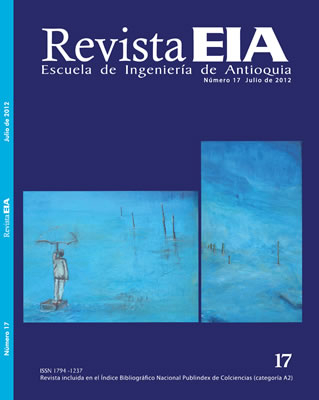APLICACIÓN DE REDES NEURONALES EN LA CLASIFICACIÓN DE ARCILLAS (APPLICATION OF NEURAL NETWORKS IN CLASSIFICATION OF CLAYS)
APLICACIÓN DE REDES NEURONALES EN LA CLASIFICACIÓN DE ARCILLAS (APPLICATION OF NEURAL NETWORKS IN CLASSIFICATION OF CLAYS)


This work is licensed under a Creative Commons Attribution-NonCommercial-NoDerivatives 4.0 International License.
Copyright statement
The authors exclusively assign to the Universidad EIA, with the power to assign to third parties, all the exploitation rights that derive from the works that are accepted for publication in the Revista EIA, as well as in any product derived from it and, in in particular, those of reproduction, distribution, public communication (including interactive making available) and transformation (including adaptation, modification and, where appropriate, translation), for all types of exploitation (by way of example and not limitation : in paper, electronic, online, computer or audiovisual format, as well as in any other format, even for promotional or advertising purposes and / or for the production of derivative products), for a worldwide territorial scope and for the entire duration of the rights provided for in the current published text of the Intellectual Property Law. This assignment will be made by the authors without the right to any type of remuneration or compensation.
Consequently, the author may not publish or disseminate the works that are selected for publication in the Revista EIA, neither totally nor partially, nor authorize their publication to third parties, without the prior express authorization, requested and granted in writing, from the Univeridad EIA.
Show authors biography
Las arcillas son la materia prima fundamental en la fabricación de productos para el sector constructor
tales como baldosas, enchapes, pavimentos y ladrillos. Las pequeñas y medianas industrias ladrilleras por lo general utilizan arcillas de diverso origen mineralógico, clasificadas para formular sus mezclas con base en la
experiencia del equipo de personas responsables de la producción; la incertidumbre asociada con este método
causa que una parte de sus productos se rechacen después de fabricados, porque sus propiedades no cumplen las especificaciones técnicas. En este artículo se presenta una metodología basada en redes neuronales que permite clasificar, con base en sus propiedades, las arcillas que se van a usar para componer las pastas, con el propósito de disminuir la cantidad de producto rechazado. Se emplearon diversas topologías de red para la clasificación, lo cual permitió encontrar una capaz de predecir las muestras de entrenamiento y prueba con 97,79 % y 94,12 % de precisión, respectivamente.
Abstract: Clays are the main raw material in the manufacture of products for the construction sector, such as tile, veneer, flooring and bricks. Small and medium enterprises generally use brick clays of different mineralogical origin, classified in order to formulate their mixtures according to the production team experience; the uncertainty associated with this method causes that a portion of their manufactured products are rejected, because their properties do not meet the technical specifications. This paper presents a methodology based on neural networks for classification of clays, based on the clay properties to be used to make the pasta, with the aim of reducing the number of rejected products. It used different network topologies for classification, and chose the one which have been found capable to predict the training and testing samples with an accuracy of 97.79 % and 94.12 %, respectively.
Article visits 276 | PDF visits 153
